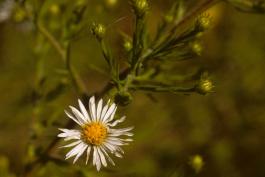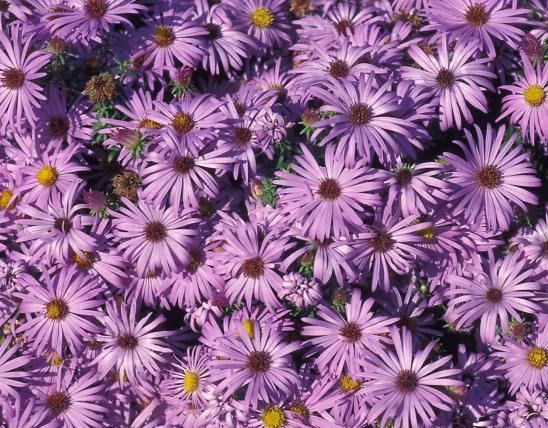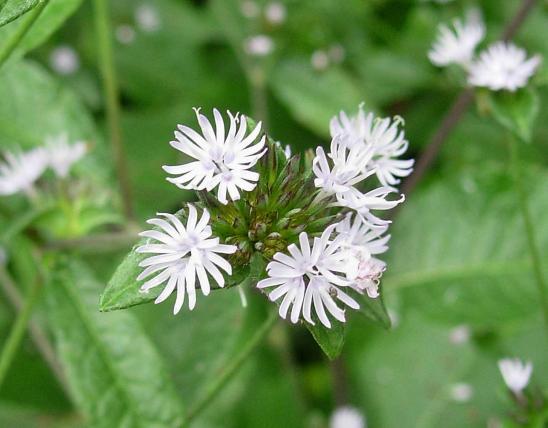
White heath aster is a much-branched perennial, with branches spreading or ascending; the stalks may be hairy or not. It is a spindly-looking plant with many small needle-like leaves all along the flower stems. Each flowerhead arises on its own peduncle (stem), which usually has a number of tiny bracts; each flowerhead has 16–35 white (sometimes pink) ray florets and a yellow disk about ¾ inch across. Blooms August–November. Leaves are linear, often needlelike, usually less than ⅜ inch wide, variable in length.
Similar species: Missouri has 24 species of New World asters (Symphyotrichum spp.; formerly placed in the genus Aster). Most have purple or white ray flowers and yellow disk flowers that turn reddish over time, and most bloom in late summer and fall. The other usually white-blooming species recorded for Missouri are rice button (bushy white) aster (S. dumosum); wreath (white heath) aster (S. ericoides); white prairie aster (S. falcatum); white woodland aster (S. lateriflorum); Ontario aster (S. ontarionis); small white aster (S. parviceps); small white aster (frost flower) (S. racemosum); inland saltmarsh (freeway) aster (S. subulatum); and white arrowleaf aster (S. urophyllum).
Of these, small white aster (S. parviceps), with its inrolled spinelike tips to its involucral bracts, looks most similar to white heath aster, but it is much less common and has smaller, fewer-flowered heads.
Height: to 5 feet.

Common statewide.
Habitat and Conservation
Occurs in uplands, bottomlands, and nearly all habitats in between: prairies, glades, forests, savannas, banks of streams and rivers, margins of ponds, lakes, and sinkhole ponds, fallow fields, pastures, old fields, fencerows, gardens, railroads, roadsides, and open, disturbed areas.
This species is not common in high-quality native habitats. It is more commonly found in overgrazed pastures, roadsides, and other disturbed places.
It is quite hardy, and it is easy to establish as a profuse, late-blooming member of a wildflower garden. Because it readily self-seeds, it can spread aggressively.
Status
Other common names include frost aster (for its hairy, “frosted” look), hairy aster, and hairy white oldfield aster.
This plant’s scientific name used to be Aster pilosus, but botanists in the 1990s firmly established that the big genus Aster now only applies mainly to Old World species, and that our native “asters” are not closely related to them and deserve their own genera. Thus the only “true aster” (in the genus Aster) growing wild in Missouri is an escape from gardens.
Human Connections
The pink-flowered form of this hardy native aster can be used as a beautiful, carefree, late-season ornamental in wildflower gardens, but its weedy nature can make it problematic.
Ecosystem Connections
Asters and other late-season bloomers provide nectar to many types of insects, including monarch butterflies that are migrating south.
White heath aster, in particular, has been associated as a favorite nectar source for the dogface butterfly and leonardus skipper, both locally common in the Ozarks. The leonardus skipper is single-brooded and only flies from late August to mid-October. If you want to see either of these butterflies, a good bet is to visit brushy fields and open woods in the Ozarks, in late summer and fall, where white heath aster abounds.
"Weedy" pioneer plants, like this one, are among the first colonizers of disturbed ground, helping immediately to bind the soil and prevent erosion.





























